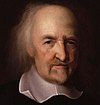United Nations History/League Visualized
According to Hobbes
[edit | edit source]
According to Hobbes, in a state of nature, we have a right to defend ourselves by any means necessary, whereas in civil society, government has a monopoly on the use of force; private revenge yields to a law-governed system of police and courts. In a state of nature our only duty is to try to get out of such a miserable condition, to try to gain agreement on a social contract that will establish civil society. In civil society, we may reasonably enter into all sorts of contracts and undertake all sorts of duties, since it is reasonable to assume that others will cooperate; in case they do not, one may go to court to have things set right.[citation needed]
Also, man is by nature selfish. A group of men by nature form a mob. Hobbes theorized government as a way to crush the "tyranny of the majority." On the global scale, nations act as people, and there is, according to Hobbes, the need for a global "League of Nations" to stop man's Selfishness.[citation needed]
The Kingdom of God is Within You
[edit | edit source]Tolstoy, writer of War and Peace, visualized a league formed to outlaw war. He stated his views in his novel "The Kingdom of God is within you." The Kingdom of God Is Within You (Russian: Царство Божие внутри вас [Tsarstvo Bozhiye vnutri vas]) is the non-fiction magnum opus of Leo Tolstoy and was first published in Germany in 1894, after being banned in his home country of Russia. It is the culmination of thirty years of Tolstoy's Christian thinking, and lays out a new organization for society based on a literal Christian interpretation.[citation needed]
Quadruple Alliance
[edit | edit source]The Quadruple Alliance of 1718 was formed by Great Britain, France, the Holy Roman emperor, and the Netherlands. This came into fruition when Philip V of Spain, guided by Cardinal Alberoni, sought by force to nullify the peace settlements reached after the War of the Spanish Succession (see Utrecht, Peace of). An English fleet landed Austrian troops in Sicily, which Spain had seized, while French and English forces entered Spain. Early in 1720, Spain yielded to the allies, but the peace terms thoroughly revised those signed at Utrecht. The Treaty of The Hague restored Naples to the house of Austria; Austria in turn promised that Philip's son Charles (later Charles III of Spain) would succeed to Parma, Piacenza, and Tuscany. Savoy, in exchange for yielding Sicily to the house of Austria, received the island of Sardinia and became the kingdom of Sardinia. Spain joined the alliance. A progressive rapprochement between Spain and France led to the Family Compact of 1733 and a further redistribution of territories after the War of the Polish Succession (1733–35). The Quadruple Alliance of March 1814 was concluded among Great Britain, Austria, Prussia, and Russia at Chaumont, France in order to strengthen their coalition against Napoleon I. After Napoleon's first abdication the four powers made peace with France (see Paris, Treaty of, 1814); after Napoleon's return from Elba, they defeated him in the Waterloo campaign and imposed on France the more severe Treaty of Paris of 1815. On the same day that treaty was signed (Nov. 20), the Quadruple Alliance was renewed in order to insure the treaty's execution. The so-called Holy Alliance, signed a few days earlier by Russia, Austria, and Prussia, became confused with the Quadruple Alliance, especially since the international congresses at Aachen (1818), Troppau (1820), Laibach (1821), and Verona (1822)—which were held according to provisions of the Quadruple Alliance—increasingly shaped the policy of the Holy Alliance, while England retired into “splendid isolation.” In 1818, France joined the powers of the Quadruple Alliance to form a Quintuple Alliance. The Quadruple Alliance of 1834 was formed by Great Britain, France, Spain, and Portugal for the purpose of strengthening the constitutional government of Spain and the throne of Isabella II against the Carlists. The Spanish marriages (1846; see Isabella II) ended Franco-British cooperation in Spanish affairs.[citation needed]
Other Contributors to the Concept
[edit | edit source]The concept of a peaceful community of nations had been outlined as far back as 1795, when Immanuel Kant’s Perpetual Peace: A Philosophical Sketch outlined the idea of a league of nations that would control conflict and promote peace between states. International co-operation to promote collective security originated in the Concert of Europe that developed after the Napoleonic War in the nineteenth century in an attempt to maintain the status quo between European states and so avoid war. This period also saw the development of international law with the first Geneva conventions establishing laws about humanitarian relief during war and the international Hague Conventions of 1899 and 1907 governing rules of war and the peaceful settlement of international disputes. The forerunner of the League of Nations, the Inter-Parliamentary Union (IPU), was formed by peace activists William Randal Cremer and Frederic Passy in 1889. The organization was international in scope with a third of the members of parliament, in the 24 countries with parliaments, serving as members of the IPU by 1914. Its aims were to encourage governments to solve international disputes by peaceful means and arbitration and annual conferences were held to help governments refine the process of international arbitration. The IPU's structure consisted of a Council headed by a President which would later be reflected in the structure of the League.[citation needed]